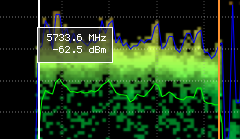802.11ac RF Hands-On with Buffalo AirStation WZR-1750H
by Brian Klug on January 11, 2012 5:06 PM ESTWe just stopped by Buffalo's booth at CES 2012, who were kind enough to let us use a WiSpy DBx from Metageek we're working on reviewing to look at an 802.11ac signal. The WiSpy DBx is an inexpensive (for spectrum analyzers) spectral analysis tool, and with 802.11ac specifically the interesting thing to look at is what 80 MHz OFDM window. This is as opposed to the 20 or 40 MHz channels that are a part of 802.11n.


With the markers shown, clearly 80 MHz OFDM
Buffalo was running a 3x3:3 80 MHz 802.11ac demo at their booth, with two AirStation WZR-1750H APs and their visible Broadcom miniPCIe 802.11ac solution visible. The two cards were just wired together (even though 802.11ac works on 5 GHz) just to ensure no spectrum crowding issues affected the demo. However, Buffalo let us get nice and close to the pigtails, close enough to catch some of the 5 GHz RF leaking out. Wired together the simple network with two APs talking to each other was doing just over 800 Mbps of traffic.
















16 Comments
View All Comments
jwilliams4200 - Wednesday, January 11, 2012 - link
So, let me get this straight. They took a wireless protocol that is touted to be able to achieve 1300Mbps, but they WIRED two pieces of equipment together instead of using wireless, and they only achieve 800Mbps??The next obvious question is how bad is the throughput when they, you know, actually use wireless equipment without a wire?
UpSpin - Wednesday, January 11, 2012 - link
Not really correct. They used a wireless transmission, but instead of air, they used a shielded and artificial perfect environment with 3 solid copper cable.But you're right, it's a poor result with such a prefect scenario only delivering 60% of the theoretical transfer rate, this means, it will drop at least another 50% using air and environmental noise..
jkostans - Wednesday, January 11, 2012 - link
It's not wireless transmission when the two devices are connected directly with what looks like 3 standard coaxial cables. Coaxial wave guide is not considered wireless by any means, and skipping the antennas is HUGE for the signal to noise ratio. As your signal to noise degrades so does your ability to correctly demodulate the signal. I'm sure it still works but those throughput numbers for the utmost ideal case an nowhere near real world.Guspaz - Wednesday, January 11, 2012 - link
They wired it together because there'd be way too much interference at a conference like CES from the zillions of other wireless devices. It got 813 Mbps because 1300 Mbps is the PHY rate, not the practical throughput. This is much the same as how a 54 Mbps 802.11g will only give less than half of that (or less) even under ideal conditions.There are a variety of reasons why the actual throughput is significantly lower. Overhead is a big one, because there are a lot of layers of overhead involved here, from the PHY all the way down to TCP.
jwilliams4200 - Wednesday, January 11, 2012 - link
Not a good excuse. If there is too much interference for the product to work, even when the devices being linked are RIGHT NEXT TO EACH OTHER, then the product is not very good. Heck, if they were so worried about interference, they could have taken a box, lined it with aluminum foil, and up-ended the box over the two pieces of equipment.MGSsancho - Wednesday, January 11, 2012 - link
Sure it could drown out everyone else but using power levels not allowed by the FCC.jwilliams4200 - Thursday, January 12, 2012 - link
The thing about RF is that it attenuates with distance. So all you need to do to "drown out everyone else" with allowed FCC power levels is to put the communicating equipment right next to each other.0ldman79 - Friday, January 13, 2012 - link
I run a wireless ISP using 802.11, so I have a tiny bit of experience.With something like this, I can see wanting to control your environment a bit. If someone really wanted to make this fail they could bring a 5GHz Motorola Canopy AP, a battery and a tiny antenna in a backpack and completely sabotage the presentation.
No WiFi device is going to work properly with thousands of clients in a small area. NONE. Even if they're not connecting, the sheer number of client devices seeking a network and transmitting the tiniest bit of data to handshake with a network that they are not even connected to is huge. The noise floor in the 2.4GHz band is probably completely fried there with 5GHz being a little better.
That being said, 802.11n in full 3x3 is quite impressive, 802.11ac doesn't look revolutionary as it has been presented, quite evolutionary and just the next logical step. The part that looks the most interesting to me is that a multi stream system can communicate with different devices simultaneously with separate streams, at the cost of total bandwidth of course.
jwilliams4200 - Friday, January 13, 2012 - link
I already explained what they could have done if the interference got really bad. It is not hard to rig up a simple Faraday cage with a box and some aluminum foil. It takes no longer than it does to rig up three coaxial cables to wire the boards together.0ldman79 - Friday, January 13, 2012 - link
So, you've made a presentation like this with prototype wireless hardware and thousands of smartphones in the room, hmm?